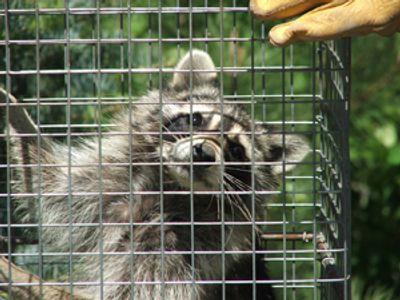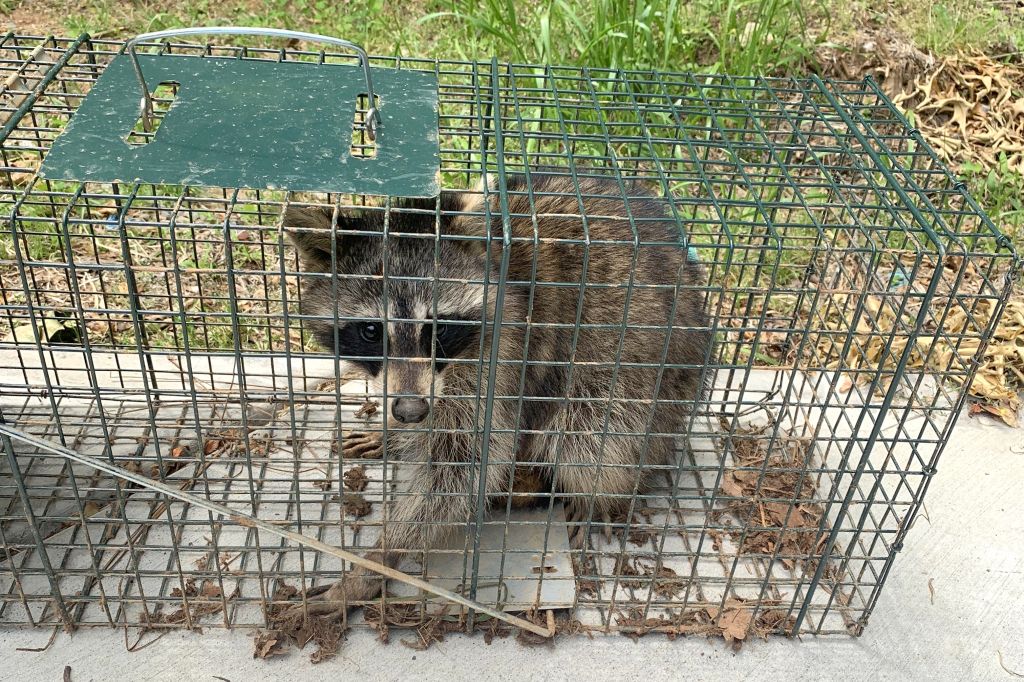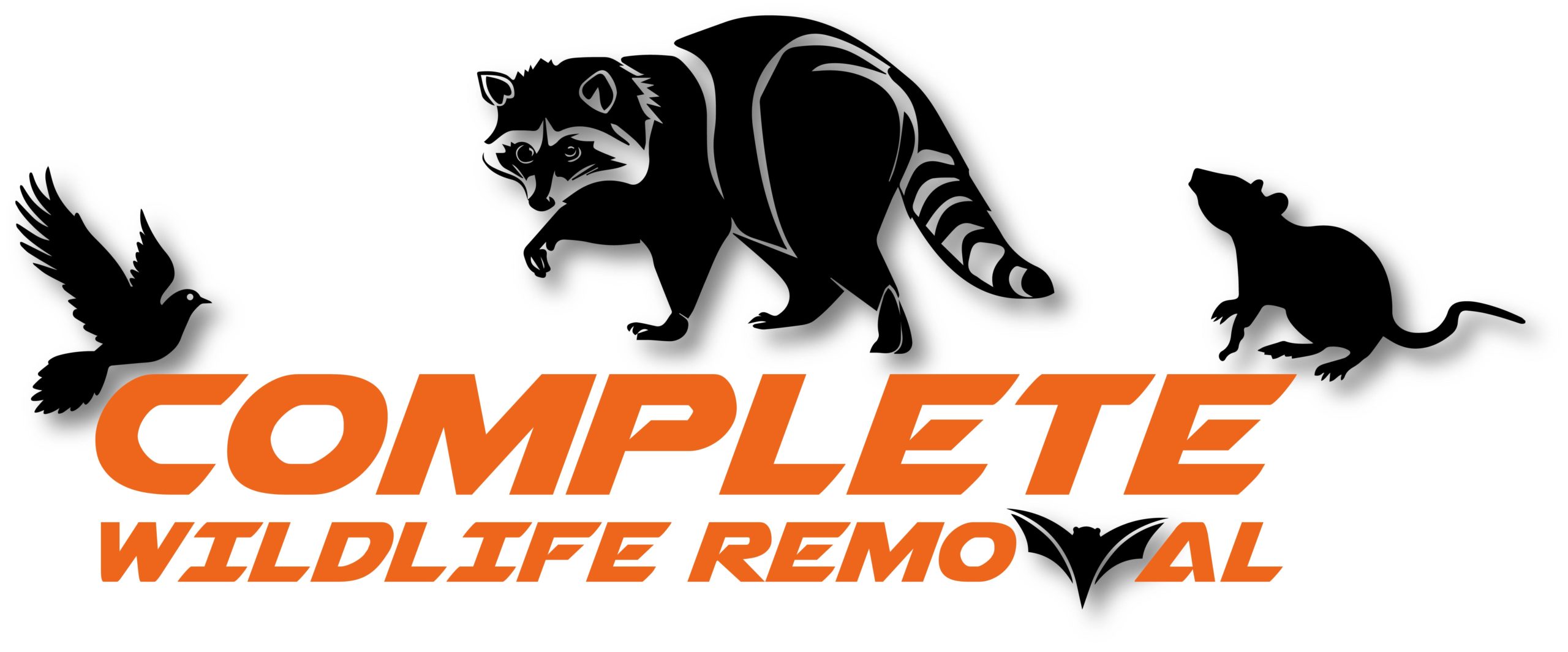Raccoon Removal

Raccoon Removal
Despite their beloved status as nature’s bandits, raccoons are wild animals that can cause quite a bit of damage when they take up residence in your home or building. The longer they inhabit your space, the higher the likelihood of expensive damage to features like your home’s insulation, your electrical and wiring systems, your ducts, and materials like wood or carpet.
In most states, raccoons are protected under state law, and a special license or permit is required to hunt or trap them. The laws regarding what to do with a trapped raccoon also vary from state to state. This nuance means that it’s much easier to leave the process to professionals who are familiar with state laws, in addition to the safety benefits of a professional that we’ll explore below.

If you think you have a raccoon living in your home, contact Complete Wildlife Removal right away to take care of the problem as soon as possible. We’re based out of Salt Lake City and Park City, Utah.
How raccoons enter residential spaces
As a species, raccoons tend to show little fear around humans—especially in urban or suburban areas where contact with humans is a regular occurrence. As a result, raccoons commonly rest in attics, crawl spaces, and chimneys in their search for shelter or food sources.
Raccoons also have adaptations that allow them to more easily enter your space, including natural dexterity that allows for opening doors and unlatching windows and intelligence that can lead to creative entry solutions.
The potential damage caused by raccoons
Raccoons can cause a variety of problems when they enter your home. Most commonly, you’ll experience damage on your roof or in your attic, walls, or crawlspace. You may also see damage to your yard or gardens as the raccoons move in and out of your home.
Raccoons can also be dangerous to humans for a few reasons. First, raccoons aren’t typically afraid of entering human spaces but can get hostile when they’re provoked or trapped. Second, raccoons are known carriers of rabies and another disease called raccoon roundworm, both of which can be deadly if passed to humans or to pets or other animals in your home.
Because raccoons are larger animals than some other pests that take up residence in homes, it’s likely that you’ll be aware of your raccoon problem early on. However, the downside of raccoons’ size is that they can inflict more damage on your property in a shorter amount of time. Raccoons have been known to tear up insulation in attics and walls, chew through electrical wires, rip up ducts and vents, scratch wood or other raw materials, and leave additional damage caused by urine and scat.
For these reasons, it’s important to bring in a professional wildlife removal company as quickly as possible to protect your home from further damage and to protect your family and pets from danger.

How to eliminate raccoons from your home
Our process for removing raccoons from your home follows the same general process as the removal of other animals. We’ll assess where the raccoons have taken up residence, monitor the area to identify all potential entry points the raccoons could be used for passage, then trap and remove the raccoons and finally seal off all the entry points.
Locating entry points is often simpler for raccoons than for other animals simply due to the size of the opening required. This may mean there are fewer entrances to seal off, which can increase the likelihood that the problem will be taken care of in one visit. If there are baby raccoons or food sources located in the raccoons’ makeshift habitat, we’ll address that issue as well to take every precaution in preventing their return.
As we mentioned above, raccoons can become hostile when they’re trapped (or when you attempt trapping), so it’s especially important to leave this step to professionals. Our team is made up of seasoned professionals who are experts at wild animal control and highly trained in the best methods and equipment to trap and remove pests. It’s our job to know each animal’s habits, their most active seasons and times of day, and—most importantly—the most effective and efficient techniques to trap them.

In addition to protecting your home from live raccoons, we’ll also remove any dead raccoons that might have been living in your walls, attic, or crawl space. You’ll know this may be occurring if there’s an overwhelming smell coming from these areas, and the rotting animal may also attract flies, rodents, and other pests. (Note that if the dead animal is not a raccoon, we’ll remove whatever it turns out to be. If all we have to go by is a smell, we may not know what the creature is until we remove it.)
Finally, as part of the cleanup process, we’ll remove any scat left by the raccoons to ensure that your home is safe and free of any contaminants that could pose a risk to humans and pets. We’ll also restore any damage that may have occurred due to the raccoons’ entry.
Timeline, cost, and other factors
The timeline, cost, and effectiveness of this process depend on many factors, including how many raccoons are in your home, whether they’re alive or dead, whether a nest has been established, and how many possible entry points exist. Once we’re finished with our process, it’s important to monitor the space for any new holes or signs of re-entry on the part of the raccoons. If that occurs, we may have to repeat the procedure to fully rid your space of the nuisance.
Long-term, it’s important to try to remove features that may attract raccoons, like unsecured trash cans, fallen fruit or seed, or leftover pet food. You can also periodically wash your trash cans to eliminate lingering smells. These food sources give the raccoons a compelling reason to try to find new access to your home, even after we’ve sealed any existing pathways. Ultimately, when you have a raccoon in your home, the safest and smartest course of action is to bring in professionals right away. At Complete Wildlife Removal, our team is highly trained in taking care of the problem with minimal impact on the raccoons or your home, leaving your space raccoon-free and once again safe to inhabit. Based in Salt Lake City and Park City, Utah, we’re currently serving clients across Utah, Wyoming, and Idaho. Give us a call about your raccoon problems today!

How to Keep Raccoons Out of The Basement
There are mixed feelings about raccoons for many homeowners in the United States. Here, alas, the critters seem to be a fairly common occurrence in urban areas, and pretty much anywhere else humans are living. Why? Well, the more our society expands, the less wild habitat there’s left for the little critters, so raccoons have had no choice but to start prowling human dwellings in search of food and shelter. If you do have a raccoon in the basement visit raccoonatticguide.com.
But maybe you don’t want a raccoon coming over for supper, so in this article, we at Complete Wildlife Removal are going to tell you how to keep the little critters out.
Regularly Clean Your Basement.
The reason why most wildlife prefers areas like the basement or the attic is that these rooms are the least populated in your house. Here, a raccoon can make a home for itself, without encountering too much trouble from the humans living in the house.
These rooms are also traditionally used for storage, which means they’re messy, and almost always easy to hide in. So a good way to keep raccoons out of your basement would be to regularly clean them out, and get rid of unnecessary items. That way, the fewer things you have in your basement, the fewer chances there are for a raccoon to come by.
Take Care of How You Store Food.
Again, the number one reason why raccoons like human homes are that here, they can find plenty of food. That’s another reason why they like basements because people often use them to store food, such as tins, cans, and so on. Whenever picking up food to store in your home, make sure you pack it tightly, in containers that are hard to open. Don’t keep food in containers that can easily be toppled and opened, otherwise, you’re practically inviting raccoons to pay you a visit.
Inspect the Basement for Potential Entry Points.
Raccoons are fairly wily creatures. They’ve been known to find a way into a home if they deem it worth their while. So you’re never 100% safe from raccoon entry. At the same time, we at Complete Wildlife Removal know that things are a little more complicated than that. The truth is, our homes are regularly deteriorated by harsh weather, and regular wear and tear. This is why it’s smart for any homeowner to regularly perform maintenance work and check the walls, windows, and so on, of their home. Even a small crack in the window frame can permit the entry of a smaller animal. And the more holes and cracks you’ve got in your basement, the easier it will be for raccoons and other animals to make their way in. So our advice would be to check the structure of your basement (as well as the rest of the rooms in your house) at least once per season, to make sure there are no potential raccoon entry points.
Call a Professional.
There are many things you can do to minimize the risk of attracting raccoons or other wildlife animals to your property. And you can do many of these yourself, as seen in the lines above. However, there is no rivaling the work of professional wildlife removal and prevention service.
At Complete Wildlife Removal, we also perform preventive inspections, during which we keep an eye out for potential attractors or weaknesses on your property. Afterward, we advise you on making your home into a wildlife-free paradise. So if you’re worried about raccoons on your property, or any other kind of wildlife, make sure to give a pro a call!

How to Get Raccoons Out of The Attic?
Most property owners across the country have dealt with raccoons, at some point, unfortunately. Raccoons are a common house guest, largely because of their versatility, and so, we’ve compiled this quick and easy guide to help you get rid of raccoons from your property, namely the attic.
Why are we focusing on the attic?
Well, because this is the least inhabited room in your home. Since most attics are used for storage, they provide a lot of nesting and hiding spaces for wild animals, which makes them quite popular. They’re also suitably dark, and yet offer adequate protection from other wild predators. So let’s talk a bit about getting raccoons out of your attic.
How do you get raccoons out of the attic?
First, make sure you are dealing with a raccoon.
It’s not uncommon for inexperienced homeowners to mistake attic noises made by one animal for another, which then leads to improper removal attempts, which will cause more damage than good. So first, you need to make sure it is a raccoon you’re dealing with.
Some tell-tale signs of a raccoon invasion include walking or trampling sounds up there at night, and chirping, which is a sound made by baby raccoons. You might also hear a noise like banging up there, which may also indicate raccoons.
Purchase a live trap.
Live trapping is the only humane and fair solution to your raccoon problem, and we at Complete Wildlife Control heartily support humane wildlife removal. Basically, this cage will use raccoon bait to lure the animal inside and trap it there, thus allowing you to safely relocate it to a new home (in the wild).
If you’re dealing with raccoon babies, we suggest using the live trap to first trap the mother raccoon, so that you can afterward go in and handle the babies. Otherwise, you risk being attacked by the mother raccoon, and we’re sure you don’t want that.
When relocating the raccoons, keep the family together, because doing anything else would be cruel.
Call a professional.
Not to toot our own horn here, but truly, nothing beats having a qualified wildlife removal professional up there. A company like Complete Wildlife Control will be able to remove the raccoon(s) safely and efficiently, but also will most likely handle the repair. Raccoons are known to cause quite a bit of damage to insulation, wires, and even roof structure, which is why we recommend taking measures to remove them as soon as you know they’re there. The more time you leave the raccoons in your attic, the more you’ll need to fix.
Getting back to hiring a professional wildlife removal company, they will also figure out the raccoon’s entry point, and help you prevent future raccoon invasions. So all in all, we tend to think this is the best option for removing raccoons or any other wild animal from your home.
Scare the raccoons out.
Another option may be to scare the raccoons out of the attic by using loud noises, or alternatively, bright lights. Raccoons will flee if they feel threatened, so this may be a somewhat effective measure.
Seal the entry point once the raccoons are safely out of the attic.
The most important step here is sealing the raccoon’s entry point swiftly, so as to avoid attracting more. So seal off any access points, and then move on to cleaning and repairing the attic. For future prevention, you may also want to limit food and water sources, since that’s most likely what’s attracting raccoons to your property in the first place.
Request Free Quote


